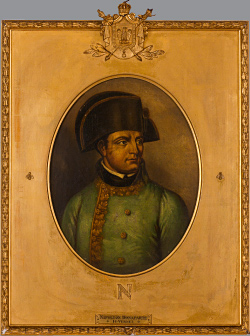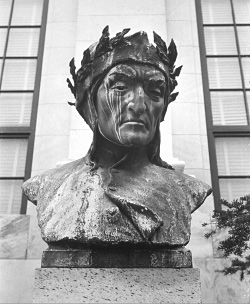 Emile Horace Vernet, Portrait of Napoleon Bonaparte (Oil on board, circa 1811).
Emile Horace Vernet, Portrait of Napoleon Bonaparte (Oil on board, circa 1811).As World War I began in Europe and political tensions began to mount at home, the Brown University Library entered a brief period of decline. Students were fewer, faculty and staff left to join the conflict, budgets were reduced, and fewer books came into the library. For five years the only acquisitions of note were a copy of Erasmus’s De Duplici Copia Verborum ac Rerum (Antwerp, 1553) and the deposit by Mira Hoffman of her husband’s collection of Napoleana. The William Henry Hoffman Napoleon Collection contains over 100 manuscripts, many signed by the Emperor, and 400 rare books, prints, art objects, and examples of fine bindings. It was formally donated to the University in 1922 and still occupies its own room on the John Hay Library’s top floor.
Following the war the pace of activity increased on campus and in the library. In 1920, over 8,000 volumes were added by gift or purchase. Among those destined for Special Collections were: the manuscript log of HMS Wolverene for 1808–1815, written while this British warship prowled the American coast during the War of 1812; Claude de Saumaise’s Defensio Regia, pro Carolo I (Leyden, 1649) bound with Milton’s Pro Populo Anglicano Defensio (London, 1652); and a collected edition of Edmund Spenser’s Works (London, 1611–1613).
 Paolo S. Abbate, sculptor. Bust of Dante Alighieri (Bronze, circa 1900).
Paolo S. Abbate, sculptor. Bust of Dante Alighieri (Bronze, circa 1900).By 1922, the Harris Collection contained over 35,000 volumes including 118 books of Brazilian poetry acquired that year. Mrs. Robert L. Northrup donated the Whittington hall clock, that now faces the Reader Services Desk, in memory of her brother, Richard Drury Rice, Class of 1916. The bronze bust of Dante by Paolo S. Abbate was installed in its present location to the left of the John Hay Library’s main entrance. Other gifts in that year included a 12 volume set of Buddhist scriptures presented by the King of Siam.
The Kimball Collection of 3,000 finely bound volumes, chiefly English literature, arrived from the estate of Walter H. Kimball, Class of 1894, in 1923. The same year, John D. Rockefeller, Jr., Class of 1897, purchased the Charles Woodberry McLellan Lincoln Collection for Brown. This collection, one of the five most important in the United States, contained 3,700 books and pamphlets, about 120 documents and letters in Lincoln’s hand, 235 broadsides and political posters, as well as medals, prints, photographs, plaques, busts, and other museum objects for a total of over 6,000 items. This striking gift was the most important special collection the library had yet received in the 20th century.
After the Lincoln Collection, acquisitions during the next few years paled in comparison, even though, in 1924, the library purchased Walt Whitman’s manuscript for Five Thousand Poems, his review of the published Catalog of the Harris Collection (Providence, 1886). The next year John D. Rockefeller, Jr. donated $5,000 for the Lincoln Collection. He was to repeat this practice, in varying amounts, for several years. These funds were soon used to purchase a deluxe set of Nicolay and Hay’s Abraham Lincoln: A History in 10 volumes extra-illustrated with 350 letters and 300 engraved portraits, a draft memorandum in Lincoln’s hand written on a blotter, and a letter written by John Hay and signed by the President.
In 1927, Rockefeller donated 435 more Lincoln letters plus $5,000 to the collection. The funds were later used to acquire the glass-plate negative of a photographic portrait of Lincoln taken by Alexander Gardner on August 9, 1863, and a copy of the reward poster issued for Lincoln’s assassins complete with their photographs.
Library purchases in the last two years of this decade included: a set of the Opera (Lyons, 1663) of mathematician Girolamo Cardano; Susanna Rowson’s novel Reuben and Rachel (Boston, 1798); and a first edition of Herman Melville’s White-Jacket (New York, 1850). A later edition of British playwright Joseph Addison’s tragedy, Cato (Boston, 1793), was added to the Harris Collection because it contained “A New Epilogue” by an American author, as was a copy of John Hay’s Pike County Ballads (New York, 1912) annotated by the poet Joaquin Miller. The manuscript for a mass composed by Franz Liszt was received from William Angell Vail, Class of 1884.